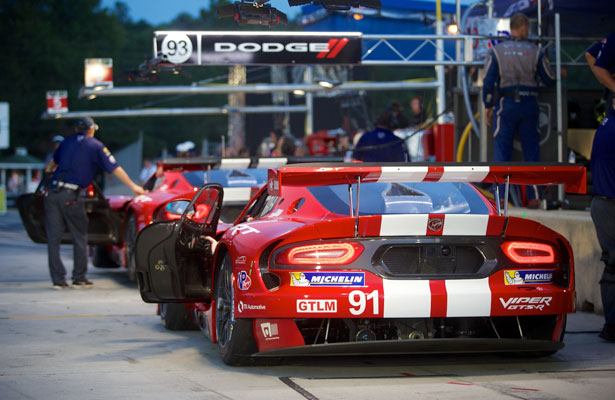SRT Motorsports will split its driver lineup for the season finale at Road Atlanta to amplify the team’s championship potential as SRT holds its first-ever series points lead entering Petit Le Mans race on Saturday, Oct. 4.
One driver from each Dodge Viper SRT GTS-R entry will swap rides for the season-ending race, with Kuno Wittmer joining the No. 91 Viper lineup and Dominik Farnbacher moving to the No. 93 race car.
By making the change, SRT Motorsports enters the Petit Le Mans with one driver competitor eligible for the TUDOR United SportsCar Championship’s GTLM class driver’s championship in each Viper – Wittmer in the No. 91 Viper and Jonathan Bomarito in the No. 93 entry. The move will provide the team the insurance of having a points-leading Viper driver remain in the hunt should the sister entry have a setback.
As Wittmer moves to the No. 91 Viper, he will be joined by full-time driver Marc Goossens and third entrant Ryan Hunter-Reay, the 2014 Indy 500 winner and 2012 IndyCar champion, who co-pilots the Viper for endurance events. Farnbacher will join Bomarito, the full-time driver of the No. 93 entry, and endurance addition Rob Bell, a two-time European Le Mans Series champion, in the No. 93 Viper.
In addition to competing for the TUDOR Championship driver’s title, SRT Motorsports is also contending for the GTLM team and manufacturer championships. The No. 93 Viper leads the team standings with 300 points, and SRT is tied for first in the manufacturer’s title rankings with 308 markers.
Bomarito and Wittmer have 300 points in the driver standings and SRT holds a seven-point advantage in both the driver and team rankings.
The lead in driver and team standings marks the first occasion the Viper program has held the points lead since returning to marquee sports car racing with a part-time schedule in 2012.
The No. 93 Viper team took the points lead with a win in the most-recent race at Texas’ Circuit of The Americas. The triumph in Austin, the second victory of the season for Bomarito and Wittmer, marked the fourth-consecutive race in which the No. 93 Viper bested the previous point leaders to surge in the standings.
The Petit Le Mans, the 11th and final event in the 2014 TUDOR Championship schedule, will take place at 11:15 a.m. EDT at Road Atlanta on Saturday, Oct. 4.
Television coverage of the TUDOR Championship race can be seen on FOX Sports 2 at 3:00 p.m. EDT on Saturday. A two-hour rebroadcast of the race airs on FOX on Sunday, Oct. 5, at various time slots throughout the country. Viewers can check local listings for air times.
Track: Road Atlanta, 2.54-mile circuit, 12 turns (race 11 of 11 for the TUDOR GTLM class)
Race: Petit Le Mans at Road Atlanta on Saturday, Oct. 4
Matt Bejnarowicz, lead engineer, No. 93 Dodge Viper SRT GTS-R
How does it feel to return to Road Atlanta?
“Road Atlanta should be another good track for the Viper. Historically, the car does very well here and we arrived onsite with two seasons worth of race and test notes to help our setup. The best passing opportunities are going into turn one and at the end of the back straightaway. The track has some difficult areas, including turn three and the esses, which is where you can get into trouble quickly with lap traffic or faster prototypes. These areas require 100 percent driver focus where it’s very easy to be surprised by a faster approaching car.”
How will the championship battle affect strategy for the Atlanta race?
“Now that we have a points lead, we will definitely be constantly watching our nearest competitors. The championships will be the priority of the race and the drivers will certainly need to control their aggressiveness to make sure we make it to the end in the proper position.”
Why did the team decide to switch the driver lineup?
“Basically to diversify. When you go into a 10-hour race or an endurance event, especially at this level, anything can happen. If you look at our history, there’s been very few endurance races we’ve gotten through unscathed whether that’s contact with another car, a mechanical gremlin, a mistake on track or by the crew. It’s very difficult to come out of a long race, especially on a short and busy track like this. I guess you just can’t plan to run a perfect race, because it’s very rare that it happens and when it does happen that car usually wins. By splitting up the two drivers, that gives us an opportunity to increase our odds. It’s a difficult decision to make emotionally because Jonathan and Kuno have both worked very hard to lead the championship where they’re at, but it’s not about one person with this team, the Viper and SRT Motorsports in general – it’s about the entire team. This way we increase our odds and the team has a better chance to win the championship. It’s about the team and it’s the best thing to do for the team.”
How did the team react to the decision?
“The initial reaction is always that you start to think, ‘Why would you do that?’ But I think it was clear right away that it really made sense. I think our drivers are spectacular in that they’re really not out driving for themselves. They are out there doing their part as a team. They reacted very well to it. They understood the logic and it made sense and they agree with the decision.”
What are the biggest challenges involved with a 10-hour race?
“With all endurance races, staying out of trouble until the final hour is critical. Road Atlanta is probably one of the most difficult endurance races, due to the shorter track length with the amount of cars on track. Add in the fast, full-commitment sections and the race will no doubt have its drama and we need to find a way to steer clear of it. On top of it all, mechanical issues are very possible in a race this length. You never know what little gremlin could come out to bite you and take you off the lead lap.”
Are there any differences between endurance and sprint-format prep?
“Absolutely. The cars will receive fresh engines for the events and low mileage components, including the gearbox, axles, suspension and body work, among other items. Brakes will be changed to endurance levels. The cars will also be equipped with quick fill fittings should the fluids of the car need to be topped off through the race. A total of three extra sets of body work will be on stand-by for both of the cars.”
What has allowed the No. 93 Viper to have a consistently successful second half of the season?
“Honestly, there are so many factors that have gone into this. Consistency with the drivers and their ability to steer clear of trouble, great preparation of the race cars by the crew, excellent engineering in the setups to maximize the speed of the car and rock-solid pit stops by the crew. Each area of the team has been at its best.”
What will it take to have a successful race at Road Atlanta?
“The team will have to be firing on all cylinders. Road Atlanta will be a 10-hour, sprint race. We need to have excellent pit stops, call the right strategy and keep the cars out of trouble for 10 hours on track. Consistency and steering clear of incidents on track will be required to be up front at the end.”
How did the Atlanta test help prepare the team for this race weekend?
“We learned a lot about the race cars and how to make them faster through the season. When we arrive at the last race of the season, we take a look back to the last season race and typically see that we have changed the way we setup the race cars. The test at Road Atlanta allowed us to try out some of the philosophies in setup that we have evolved through the year and compare them to last year’s setup. There is such limited time during the race week that you simply cannot do this. The Atlanta test allowed us to scientifically step through many different setup areas to understand how they can improve the car for the race. The second difficulty during the race week is driver time. The fact that some of our drivers benefited from two days of testing will shorten our time to get the entire team up to speed.”























